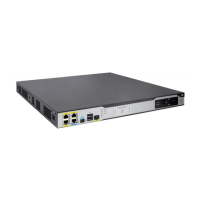437
Usage guidelines
When the security log file is full, the system deletes the oldest logs and then writes new logs to the
security log file. This feature helps avoid security log loss by setting an alarm threshold for the
security log file usage. When the threshold is reached, the system outputs log information to inform
the administrator. The administrator can log in to the device as the security log administrator, and
back up the security log file.
Examples
# Set the alarm threshold for security log file usage to 90.
<Sysname> system-view
[Sysname] info-center security-logfile alarm-threshold 90
Related commands
info-center security-logfile size-quota
info-center security-logfile directory
Use info-center security-logfile directory to specify the security log file directory.
Syntax
info-center security-logfile directory dir-name
Default
The security log file is saved in the seclog directory under the root directory of the storage device.
Views
System view
Predefined user roles
security-audit
Parameters
dir-name: Specifies a directory by its name, a string of 1 to 64 characters.
Usage guidelines
The specified directory must have been created.
To use this command, a local user must be authorized the security-audit user role. For information
about configuring the security-audit user role, see Security Command Reference.
This command cannot survive a reboot. (Centralized devices in standalone mode.)
This command cannot survive a reboot or an active/standby switchover. (Distributed devices in
standalone mode.)
This command cannot survive an IRF reboot or a master/subordinate switchover. (Centralized
devices in IRF mode.)
This command cannot survive an IRF reboot or a global active/standby switchover in an IRF fabric.
(Distributed devices in IRF mode.)
Examples
# Set the security log file directory to flash:/test.
<Sysname> mkdir test
Creating directory flash:/test... Done.
<Sysname> system-view
[Sysname] info-center security-logfile directory flash:/test

